- Home
- About us
- Products
- Dealer Enquiry
- Blog
- Contact Us
- Home
- About us
- Products
- Dealer Enquiry
- Contact Us
- 044 -2486 1994
- +91 99623 98222
- sales@nantech.in
- REQUEST A QUOTE
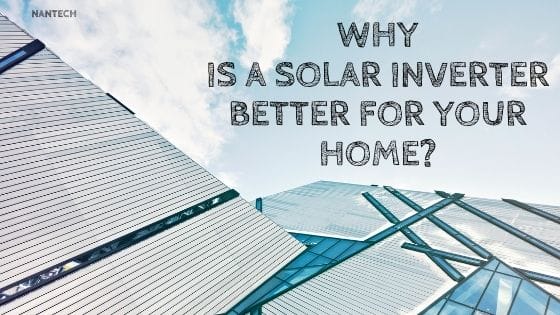
Today, fossil fuels and their by-products are being scrutinized by the world, and the focus is more on greener and environmentally friendly sources of energy. Solar Energy, mainly the use of Solar panels, has gained much traction in this field, It uses Solar Photovoltaic (PV) Cells to capture sunlight and convert that to electricity.
However one must remember that solar panels usually provide Direct Current (DC) energy. Most of our household electrical appliances use Alternating Current (AC) energy. Thus, we need to convert DC to AC, and this is where we use a solar inverter. This device converts the output current from the solar panels to AC energy, which can be used in your house.
Also Read: Aspects To Consider While Purchasing A Solar Inverter
Today, there are three types of Solar Inverter technologies that one can choose from:
In a PV system with a string inverter, the panels are wired together with 'strings,' Each panel's output can be sent back to the central inverter via this 'string.' This allows for a low-cost inverter operation and is durable and easy to maintain. These are best suited for houses with simple roofs that get sun throughout the day and for people looking for an economical and low-cost PV system.
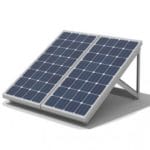 These are different from the string inverter system, and here, the solar panels each have a small inverter installed. Therefore, the conversion from DC to AC occurs right on the roof. The advantage of this system is that for systems that experience shading or have more complex designs, one can use this instead of a string system to mitigate the problems. Furthermore, it allows for panel-level monitoring since each microinverter is connected to the solar panels. These are usually high-cost, high-performance inverters, and hence one must use them for complicated roof constructions.
These are different from the string inverter system, and here, the solar panels each have a small inverter installed. Therefore, the conversion from DC to AC occurs right on the roof. The advantage of this system is that for systems that experience shading or have more complex designs, one can use this instead of a string system to mitigate the problems. Furthermore, it allows for panel-level monitoring since each microinverter is connected to the solar panels. These are usually high-cost, high-performance inverters, and hence one must use them for complicated roof constructions.
These fall in between microinverters and string inverters. These are interfaces located near (or on) the solar panels, which 'condition' the DC output and send it back to a centralized inverter. The advantage is that it helps monitor individual panels, mitigate the impact of shading, optimize the efficiency of inverters, and cost less than microinverters. These are best suited for houses or buildings with less ideal solar panel locations and whose owners are willing to pay a little extra for a better system but don't want microinverters.
Nantech Power Systems Pvt. Ltd provides the best inverters to buy in India, with its excellent product line-up, efficient services, and timely after-sales support. Check it out!

What better time than now to invest in environmentally conscious and economically sound power supply machinery? So, an inverter's basic function is to save electricity when power is available and, on the occasion of a power cut, supply power to run at least the basic machinery and appliances like fans and lights to help the user. Solar inverters like the ones made by Nantech are created using solar power as the inverter's primary power supply.
Off-Grid stand-alone inverters: These are isolated inverter systems usually supplying only a single home or office building.
Grid-connected inverters without battery back-up: Here, all the converted solar energy is stored in a central grid system supplying multiple buildings and acts as a back-up for all these buildings when there is a power- cut. There are no batteries, and these inverters have PowerPoint tracker systems for systemic power generation.
Grid type inverters with battery back-up: An amalgamation of the above two types of inverters.
Offred grid inverters are mostly used for residential users and are capable of supplying enough power for essential needs. However, it is of paramount importance that a customer knows what he is buying to avoid any kind of mishap, whether financial or physical. So here is a list of few things you should keep in mind while buying a solar inverter:
Battery Voltage range: The voltage that can be fed into the battery from sunlight.
DC current: Maximum current which it can handle.
Voltage range: The voltage that can be fed into the inverter by sunlight.
Continuous power output: The maximum time the inverter can produce continuous power at said temperature.
Output voltage: So that it is compatible with your household requirement, which is generally 210-220V.
Frequency: For India is 50 Hz.
Efficiency: The amount of actual solar energy received by the panels converted to electrical energy supplied to our homes. No Machine 100% efficient. We recommend solar inverters with galvanic insolation having an efficiency of 94% and 97% for without galvanic isolation.
No-load power consumption: The amount of energy that the inverter itself uses up without supplying to a load. It is important to determine efficiency.
Surge Power: some machines, like motors, require more power to start than the rest of its run time. We recommend surge value between 3- 6.
Output waveform: We recommend a pure sine wave property for high efficiency.
Maximum power point tracking ability: This system prevents overcharging and under-charging of the inverter.
Output voltage: So that it is compatible with your household requirement, which is generally 210-220V.
Ambient weather conditions: To preferably include your room temperature range and average humidity.
Grid frequency synchronization range: 3 Hz
Ingress protection rating: It is a protection rating, and its minimum value should be IP65.
Power factor: Greater than 0.9.
Data logging software: For user information and convenience.
Inverter warranties: Should have at least a 1-year warranty.
Also Read: A Basic understanding : Solar inverters
It is very important to consider these aspects while making a purchase. Check out Nantech’sline of the solar inverter as their products satisfy the above-mentioned features.
~Happy shopping!
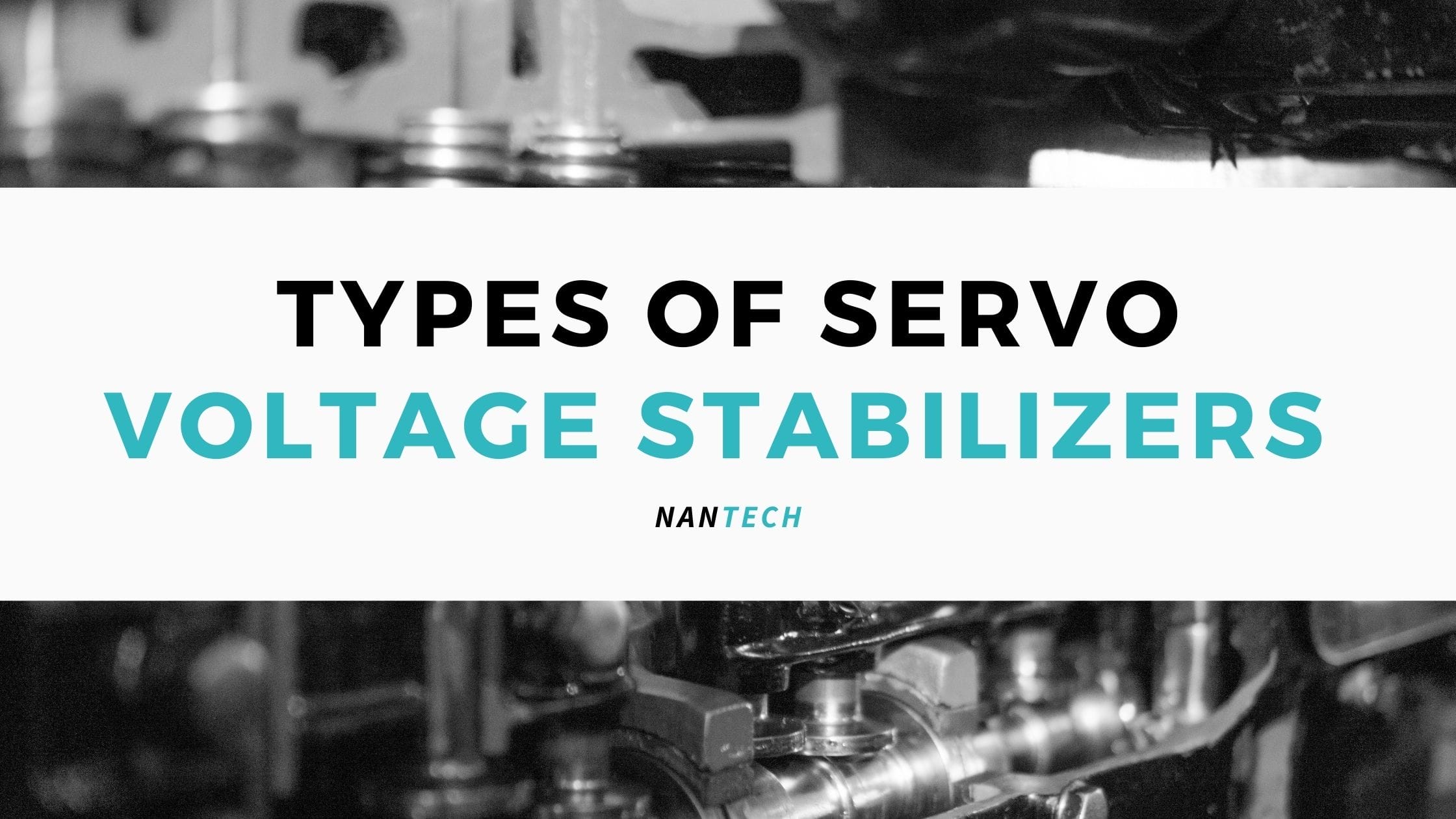
Servo Voltage Stabilizers are important electrical components for the electrical wiring of the complex. It protects electrical equipment and machines by stabilizing the voltage input and protecting it from voltage fluctuations (both over and under supplies) and other voltage floods. Hence, this is also known as an Automatic Voltage Regulator(AVR). These work with many electromechanical transfers to give a suitable yield voltage, which is usually in an ideal range.
These come either in single-phase or three-phase units, depending on the use and the connection to limit the Kilovolt-Ampere (KVA) necessary. Three-phase units further come in two different types: Balanced Loadand Unbalanced Load models.
Furthermore, they are either for a piece of particular equipment or a spot or a major stabilizer unit for a group of apparatuses (E.g., an entire house). Also, they come in computerized or as simple stabilizer units.
Apart from the transformer circuits, a rectifier circuit, controller unit, and other parts are used for bucking operations. These are relatively easy to use and have less weight, and are commonplace in households and businesses.
Instabilities are ±15% with yield exactness between ±5-10%.
Advantages:
Disadvantages:
They use servo engines to control voltage influx and hence are also called Servo Stabilizers. These have closed-circle frameworks and are basically used for high-precision voltage returns (typically around ±1%). These come in 3 types:
Advantages:
Disadvantages:
These stabilizers have static parts and hence no moving parts as compared to a servo voltage stabilizer. These stabilizers are extremely accurate and have an exactness of voltage adjustment range of just ±1%. These static voltage stabilizers contain 'Buck & Boost' Transformers, Microcontrollers, Microprocessors, and other important components.
Advantages:
These stabilizers have static parts and hence no moving parts as compared to a servo voltage stabilizer. These stabilizers are extremely accurate and have an exactness of voltage adjustment range of just ±1%. These static voltage stabilizers contain 'Buck & Boost' Transformers, Microcontrollers, Microprocessors, and other important components.
Advantages:
In conclusion, each unit has its own advantages and disadvantages, and one must carefully choose their unit according to their needs and specifications. Today, many companies are flooding the market with different types of products, and companies like Nantech Power Systems are at the top with high customer reliability and product line-up.
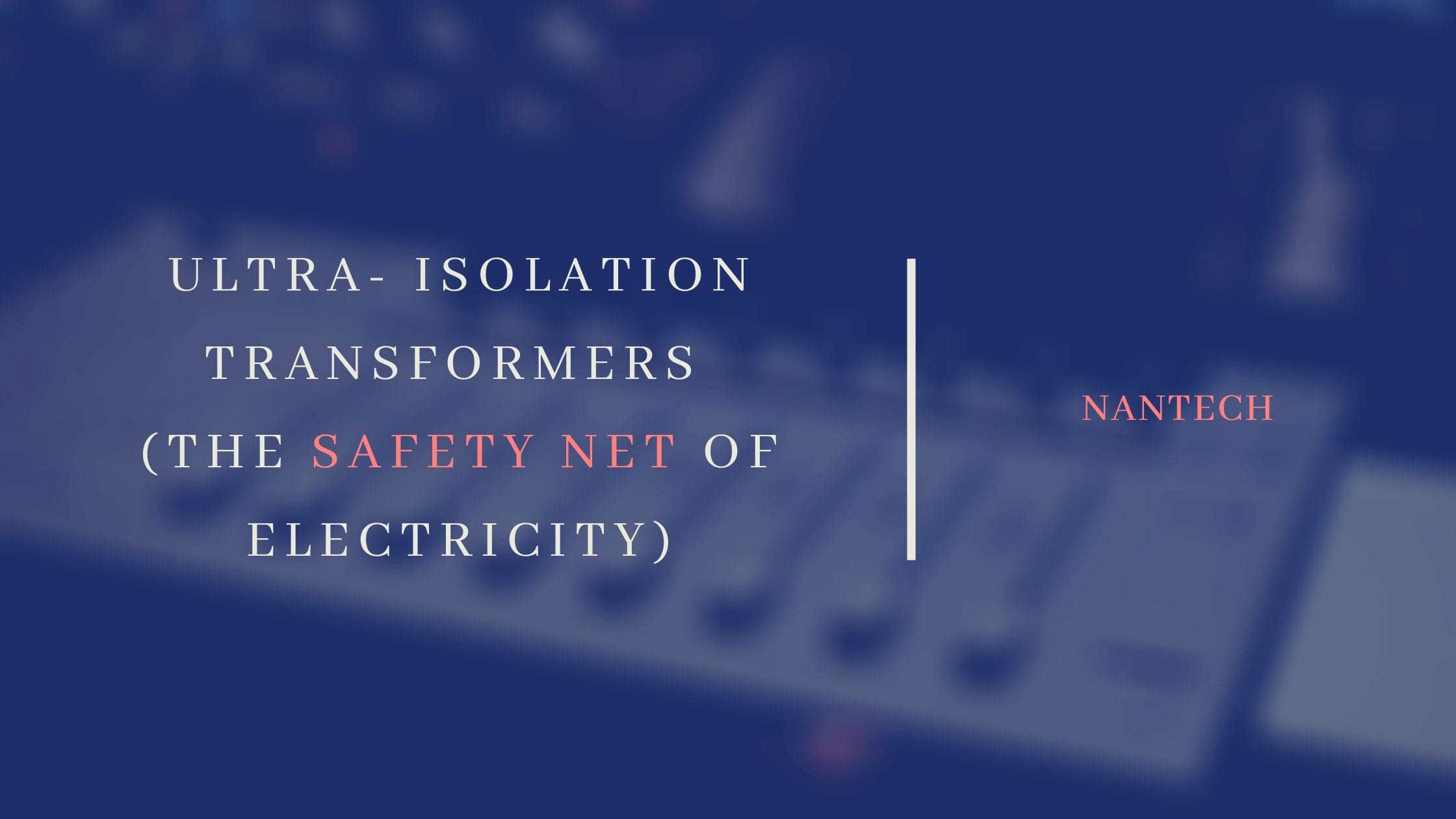
Have you ever wondered, when someone by mistake inserts their finger into an electric socket, they get electrocuted, and the finger burns? But when the same finger touches the net of those electric rackets for mosquito killing, you feel nothing more than a small shock wave with no physical effect? So it is quite evident that, based on the current, more accurately, the voltage flowing through a conductor, damage, or magnitude of use of the machine is proportionate. Just like us, even devices have a specific limit of voltage that they can handle without damaging themselves.
Generally, power lines from the power plant operate at super high voltages ranging from 155,00V to 765,000V. If that amount of voltage were to directly reach our homes and factories, all our machinery would burn down. Therefore, along the way, with the help of step- down transformers, voltage is reduced to about 120-220V till it reaches our homes. Unfortunately, this system is not properly developed in all parts of our country. There is usually an undesirable fluctuation of voltage and sound production due to interference and spikes in current, which may damage sensitive machinery in homes and factories. To guarantee the machinery's safety, 'The ultra- isolation transformer’ was created and manufactured on a large scale by various companies, including Nantech. The Ultra isolation transformer works on the basic principle that makes strong insulation amongst its primary and secondary coil, capable of withstanding surges in voltage. This essentially creates a barrier between the source of power and the machine or load, ensuring the machine's safety and any hazards that might arise from the unstable power supply.
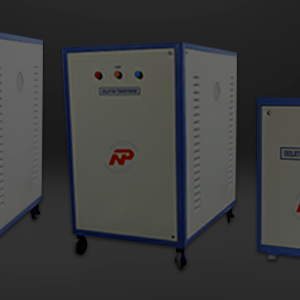
Another important use of the isolation transformer is that it reduces electrical noise and enables good electromechanical compatibility. Suppose we pay attention to its internal structure. In that case, we observe that the number of windings in both the primary and secondary coils is the same and is often used to protect other connected circuits and individuals from shock. There is a capacitive coupling between the two coils with a faraday shield to enable the transfer of energy but reduce common-mode noise.
Nowadays, due to its wide range of applications, Ultra isolation transformers come built-in with high-risk devices and are indeed a marvel of human innovation. Working on a simple principle helps entire humanity avoid harm from the lifeline of society that is electricity.
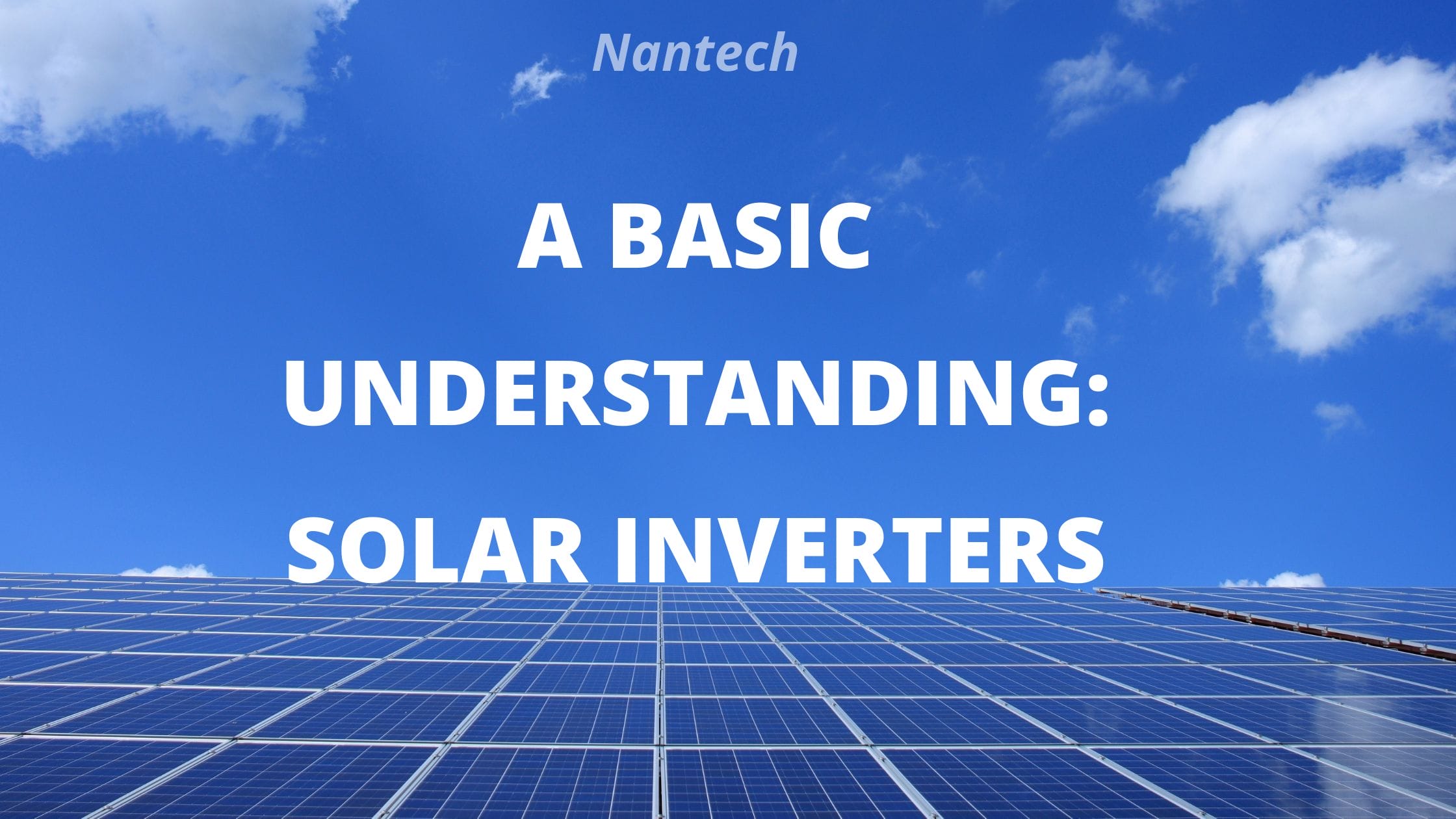
The type of electrical converter that can convert the variable direct current output of a photovoltaic solar panel into a utility frequency alternating current fed into a commercial electrical grid is known as Solar Inverters. Unlike the regular invertors, the solar panel charges the battery using solar power along with the electricity. For supreme efficiency of these solar inverters, systematic and consistent maintenance ensuring their efficacy is required for the long run of the machine.
Solar power installation provides for the benefit of the environment as this process requires no fuel burning and no radiation from energy production. Since it is pollution-free, most of the population will tend to purchase it as protecting the environment is considered the main motto of all individuals who are very well aware of the haphazardness of filthy surroundings.
The electricity generated from the solar panel can be used for smooth functioning of all electronic appliances in the home. The exorbitant current bill, which is unaffordable to middle-class people, has become more conducive to a solar heating panel. Sudden reduction in electricity bill makes everyone purchase this solar inverter as it reduces the cost of living and provides enough money for savings. It is the main heating mechanism of all homes, especially in foreign countries. Most housewives find cooking in solar energy less tiresome and an enjoyable pastime making the work less monotonous. Solar power cars are already in the market, which invariably reduces the fuel cost.
Since the sun is visible throughout the year, solar energy is a continuous process, and we cannot be in shortage of it at any point of time.
The electricity bill of houses reduces to a considerable extent after installing solar panels, which makes it more reliable and to gain more future buyers.
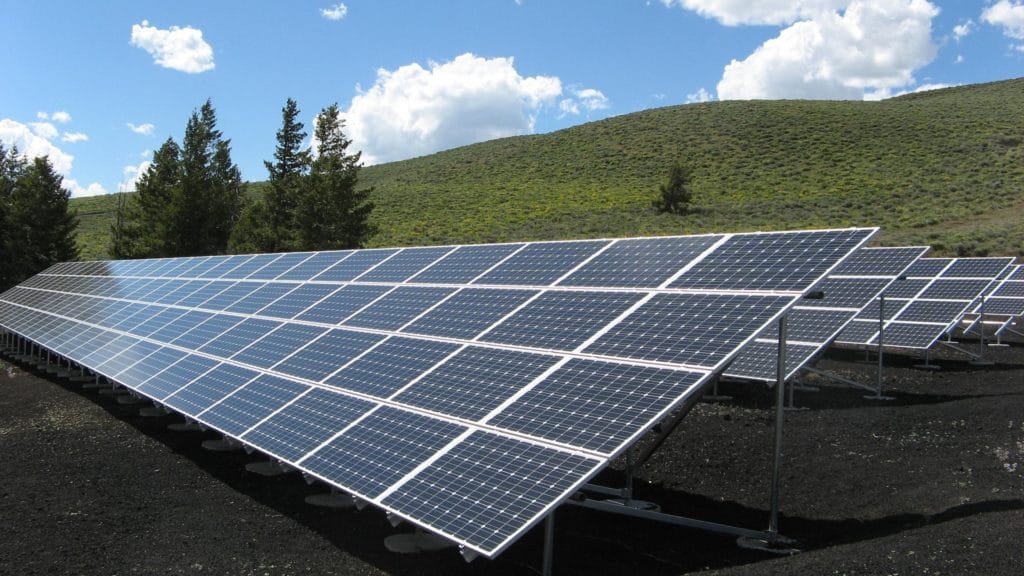
Greenhouse gases like carbon dioxide and methane, which cause pollution, are not caused by solar energy, making it eco-friendly.
We can store solar energy by increasing the number of batteries, which can be later used on a cloudy or a rainy day.
Once the solar power installation is done, it easily lasts for more than twenty-five years, reducing the maintenance cost.
It is extremely difficult to collect solar energy on a rainy or cloudy day as its efficiency decreases to such a low level during these days even though the energy can be stored through batteries.
To fit many solar panels, ample space is required in the roof area of the house. The place where the solar panel is kept should be accessible to exposure to direct sunlight. Hence solar inverters should be fixed only in places congenial for this.
Since solar inverters can't convert all their available energy into power, 100% efficiency is not arrived at by the constant use of these solar panels.
To put it in a nutshell, solar energy, which is gaining popularity through its technological development, will take some more years to reach the peak of its utility and to improve the quality of our life. By 2050, we can expect every single house to have a solar panel installed on its roof, which makes it an essential set up not an option.
If you are interested in purchase to check out Nantech’s ON-GRID, OFF-GRID and solar street light inverters.
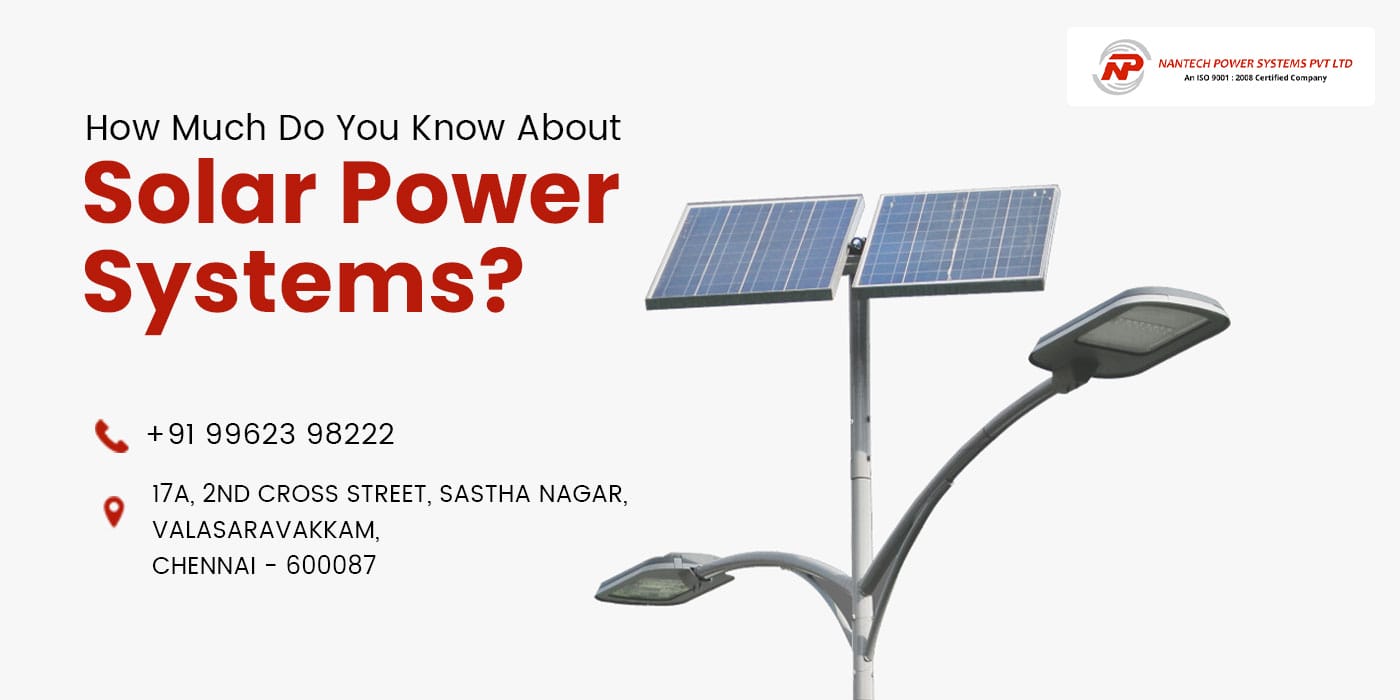
Installing a solar power system has become a fascination, a luxury and a necessity. Why waste the energy of the sun when you have it in abundance? When it comes to investing in solar power systems, the first and foremost thing is to understand everything about the solar power system- how it works, its components, its types, the various systems, etc.
This knowledge is crucial in making a choice between the Off-Grid and On-Grid solar power systems, which is quite often the big dilemma. So, what is the solar power system and how does it work?
Generated by the sun, solar power is sustainable, clean and usable energy. Irrespective of where they are used, all solar systems work on the same basic principles. The solar panel is the primary component of the solar power system. The solar panels convert direct sunlight into Direct Current using the Photovoltaic effect. The DC power is either stored in a battery or converted into AC power and used to run appliances. This is just the entire process in a nutshell!
There are four main components of the system that are common to all the types of solar panels available today:
Modern solar panels are made of PV cells or Photovoltaic cells, which are crucial to initiate the process of electricity generation. Solar panels or solar modules are connected in strings to form a “Solar Array”. To maximize the use of your solar panels, consider its orientation, tilt angles, and efficiency. Solar panels require uninhibited sunlight to fall directly on the panel. Panels require daily maintenance, and proper installation to work without a hitch.
The solar inverter plays a critical role in converting the Direct Current to grid-compatible Alternating Current which is what you use in your homes and commercial establishments. From a reliability perspective, the inverters are vulnerable, because they are the weak link in this system. Hence is it vital to choose a good quality inverter.
There are two kinds of batteries used for solar energy storage:
The electric switchboard is a handy component that collects the AC energy from the inverter and disperses it through various circuits to power your home appliances. Any excess electricity is sent back to the grid through an energy meter or stored in a battery for later use. This is commonly known as Net Metering.
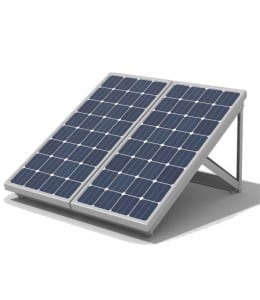 But that’s not all! Apart from the above-mentioned components, there are so many more basic parts that combine to make the entire solar power system. They are:
But that’s not all! Apart from the above-mentioned components, there are so many more basic parts that combine to make the entire solar power system. They are:
Also Read: Are We An Electricity-Surplus Nation?
Ever since its invention, the solar power system has evolved into three types:
To arrive at a proper conclusion to the dilemma of choosing between the three types, you actually have to gain a clear understanding of what they actually mean.
The On-Grid System
When your solar power system is connected to the common utility power grid, it is an On-Grid system. Most solar power systems in India are on-grid systems, mainly because they are easy to install and very economical. Solar systems that power residences are often connected to the common utility grid. Any excess electricity that your on-grid system produces can be sent to the grid, allowing you to build enough credit that you can cash out at the end of the year or month. This is an effective process called Net Metering which is very conducive for solar power owners who are looking to generate ROI.
The Off-Grid System
An Off-Grid system empowers you to be 100% self-sustained because yours is a stand-alone system that is not connected to any grid. This system allows you to store excess electricity that will come in handy at critical times. However, there is a downside to the off-grid system. It calls for heavy investment because of the complex installation that uses expensive, bulky batteries. The expenses itself can be a hurdle to gaining the actual amount of electricity you require.
The Hybrid System
The hybrid system is a clever combination of the off-grid and on-grid systems that offer an easy “plug and play” solution. With the use of special hybrid inverters, the excess energy is stored for later use. The hybrid system is quite similar to your UPS system since it serves the same purpose of providing stored energy in case of a blackout.
Take a look at just a few of the stark differences of the off-grid and on-grid solar systems:
You are completely safe with the on-grid system because you can be assured of a consistent power supply. But the off-grid system is not so promising. With limited battery backup, the off-grid system relies entirely on the power of the sun to generate electricity. You wouldn’t want to encounter such a dilemma on a rainy day, would you?
The on-grid system not only allows you to draw stored energy from the grid when you need it but also generates an income with Net Metering where you are credited for the amount of electricity your system generates. With off-grid systems, you do not have the advantage of net metering and you need to invest in plenty of batteries to store the excess energy.
Power supply during an outage
This is where the off-grid system has the upper hand because it is completely independent. The on-grid system will work during a power outage only if it has a battery backup.
Yes, there will be a few changes in your electricity bill even if you own an On-grid system. The off-grid system is not tied to a grid, so there are no bills. However, the cost of installation can go through the roof because of the equipment.
What’s the verdict?
In India, the implementation of Net Metering and open access has boosted the adoption of On-grid solar power systems. However, the Off-grid system is a better choice for usage in remote areas where the utility grid is unavailable or inaccessible.
Nantech Power Systems Pvt Ltd, the leading inverter dealers in Chennai, give you expert guidance in choosing the right solar power system for your home or commercial building. Our reliable solar power systems are exceptional in quality and backed by warranty. Waste no time! Call us today @ +91 99623 98222 to harness the power of the sun!
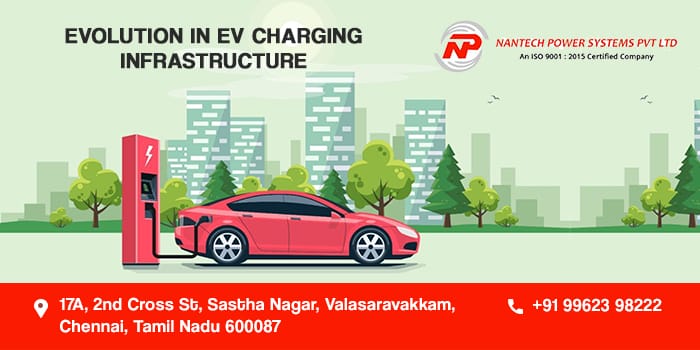
Reducing carbon emissions is going to be one of the major focuses of the government. To strengthen the effort, the Government of India has taken initiatives to increase the possibility of E-Mobility. Companies are now focusing on developing electric vehicles and the development of charging stations plays a major role in the widespread growth of EVs. As per a study, India will have around 8 million public charging facilities and 79 million electric vehicles plying on the roads by 2030. As the leading EV charging solutions in Chennai, Nantech Power Systems commits to producing sustainable and reliable premium, public, commercial, and residential comprehensive EV charging stations.
Also Read: The EV Revolution: Is Chennai Ready For It?
The transport sector accounts for 40% of total fuel consumption and in this, 90% is used for road transport. The state and central governments are now adopting slow regulations and policies to promote the use of EVs. Lack of public charging facilities is a major hurdle the EV industry faces while convincing prospective buyers. Most of the charging takes place either at work or at home. Electric vehicle charging infrastructure or EVCI needs to be increased as getting stranded with empty batteries. Successful transition to e-mobility requires affordable, accessible, and reliable EVCI.
The government has followed international standards in developing an Indian specific standard called Bharat Charging. For the successful adoption of E-Mobility, the government has been adopting new regulations, incentives, and taxation policies. They must also take care of consumer education measures. Such initiatives are required to boost consumer confidence and increase partnership in developing electric vehicle charging infrastructure. Developing charging stations is a major challenge which the government will be taking initiative along with major players in the field.
There are different types of charging infrastructure which is renewable charging hubs, charging stations in communities and charging stations in office sites. Developing such a charging infrastructure is indispensable to eliminate barriers in adopting EVs. EV solution providers can set up charging infrastructure on a company's campus for its employees or they can tie up with real estate developers to set up charging stations within their properties. The Government of India has drafted a plan to set up 2636 EV charging stations in 62 cities, including Chennai, across all states and union territories by 2023. The decision has inspired many private and state-owned power utilities industries to enter the business of improving charging infrastructure.
Agreements are being signed with battery manufacturing companies and swapping companies to initiate infrastructure development. There is a need to maintain a balance between demand and supply and innovative and meaningful collaboration with key stakeholders will help in a long way. A demand aggregation model is devised to create a boom in the market to increase mobility services and charging infrastructure. The different demand aggregation models are led by the private sector, discom, and public sector. Battery swapping will bring down the initial cost of EV to half its price.
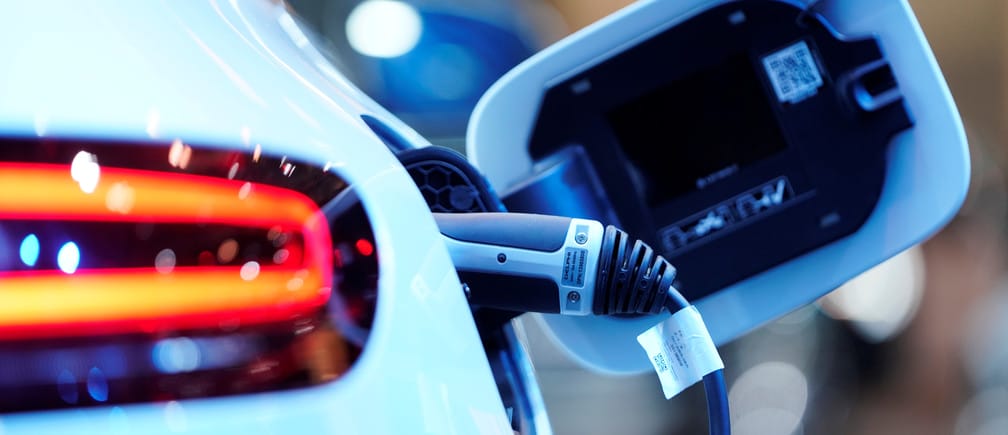
Initiatives are undertaken to have solutions to enable battery swapping affordable and done in less time. For four-wheelers, fast DC charging is the best option available. Four-wheel electric vehicles are not designed for implementing battery swapping. Indian automakers need to develop electric four-wheelers that are compliant with battery swapping. Post-COVID era will see a shift from public transportation to 2 wheelers and 3 wheelers and the battery swapping segment will find a good market as they enable electric two and three-wheelers. India has developed two standards for AC and DC charging, namely, Bharat EV Charger DC-001 and Bharat EV Charger AC-001.
The standards have recommendations and specifications for charging electric vehicles. It is expected that AC vehicles will continue for around 5 to 8 years as we kick start the electric vehicle industry. The electric two and three-wheelers manufactured in India have AC charging. Some electric cars also have AC charging fitted. In a cost-driven economy like India AC chargers are a huge advantage as they are much cheaper and manageable when compared to DC charging. DC charging is expected to gain momentum in the second half of the decade. DC chargers will be able to service multiple vehicles and will be a cost-effective option even if one unit sells at a higher price. With new technology, the price of DC is dropping and will soon outweigh the advantages of AC technology.
As technology evolves in the power sector, the government is expected to promote the use of renewable sources of energy in charging electric vehicles. The future of E‐Mobility depends on combining renewable sources with charging and battery storage. Setting up a solar power plant for DC fast charger of 25kw to 100kw batteries at public charging stations will be a huge challenge as it will involve huge amounts of expenditure. A solar plant requires huge space and it could be a challenge for setting charging stations in the city. The Faster Adoption and Manufacturing of Electric Vehicles in India or FAME 2 will also focus extensively on electric vehicle charging infrastructure.
E-mobility services will initially take off in rental services or ride-hailing services in the Indian cities, especially Chennai. With the current circumstances, this will help Indian cities to skip combustion-powered private vehicle ownership. This will help educate people on EVs and also create awareness amongst the general public. The electric vehicle industry should be able to convince people that their product is as reliable as combustion-powered vehicles.
People need to be convinced that they won’t be left stranded without battery power in the middle of nowhere. A real-time, transparent solution needs to be developed to allay fears of the consumers. There should be a platform where car owners can check the status of the battery, record data and view the nearest EV charging station. The government should also take effort to reduce GST on charging components and swapping services the same way as they did on electric vehicles. It will reduce cost and benefit consumers.
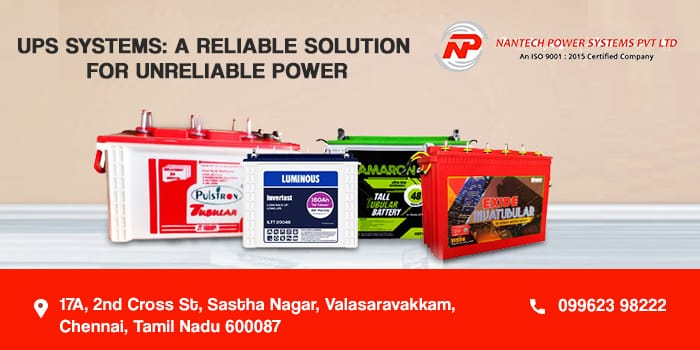
Power is anything but predictable. There is no saying when the slightest lightning can trigger a blackout, or the tiniest flaw can cause a surge that can knock out your expensive devices. Low voltages can leave you in desperation when you require that cool air from your air conditioner.
The unpredictability of power can also cause loss of property and money. What's worse is that power surges can even be life-threatening. This is where the indispensability of an Uninterrupted Power Supply comes into play. The UPS system not only provides undisrupted power but also shields your electronic appliances from a sudden power surge.
The UPS system is an omnipresent necessity in homes, businesses and commercial establishments. It plays an imminent role in protecting computer systems, telecommunication networks, machinery and delicate equipment that cannot handle the unpredictability of power. In a nutshell, the UPS keeps the work process flowing without a hitch.
Also Read: THE 101 ON SERVO STABILIZER
If you were under the impression that power surges and voltage fluctuations were the only problems that required a UPS system, you are not quite right. UPS dealers in Chennai list out various complications that the UPS can efficiently handle, making it an undeniable necessity in your homes and offices.
Types Of UPS: A detailed insight
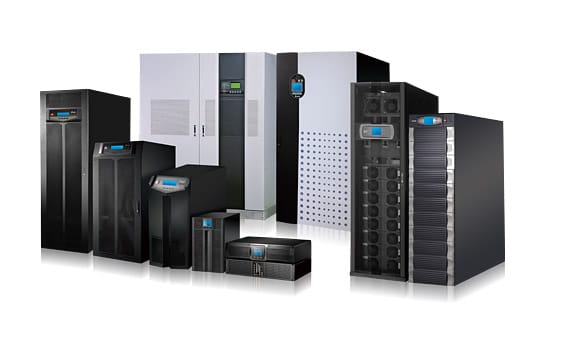
Three major types of UPS are commonly used for domestic and commercial purposes. We give you a detailed explanation of what they are and how they work.
1. Online double conversion
Also known as double conversion UPS, it is the most common UPS type that is used to power large data centres. Online double conversion UPS are highly reliable for the quality power that they supply. This support and protection are vital to handle critical loads and voltage fluctuations that can destroy a whole system of computers.
Application: large scale industries, small enterprises, LAN centres, IT parks.
2. Line-interactive UPS
A line-interactive UPS is very efficient in automatically regulating the voltage fluctuations. Widely used in applications where outages are rare but fluctuations are common, this UPS system supports a wide range of input voltage variations before switching to battery backup.
How it works: The line-interactive UPS continuously feeds power through a conditioner that keeps the battery charged at all times. It preserves battery life by using it as a last resort. Hence, the inverter becomes a part of the output and is always on "switched on" mode.
Applications: Personal computers and small range of electronic equipment.
3. Offline UPS
Also known as a battery backup or stand-by UPS, it is the most budget-friendly option. Engineered to power very basic loads and single workstations, the offline UPS is a viable option for small homes and businesses.
Applications: lights, fans, gaming consoles, domestic appliances.
Standard Features Of A UPS
How well do you know your UPS? Take a note of the standard features that every UPS is designed with:
The requirement and usage of the UPS define the kind of system you will need to choose. What is the intention of use? Do you need it for your home, office or business workplace?
These are the basic queries that will determine the size and running time of your UPS, depending on the devices you want it to power.
The line-interactive UPS is always a tad better than other types because it is built to switch from battery to utility power quickly. An online UPS is the best choice for bigger offices and homes as it can provide uninterrupted, clean energy.
Long backup runtime and the seamless switchover to battery mode are two essential factors that determine the worth of a UPs system. Your UPS should fulfil these criteria if they are to be used for powering sensitive devices
Your UPS dealer should provide you with post-delivery service and maintenance, should any issue arise. Additionally, ensure that the UPS is shock-proof and has user-friendly graphical displays to indicate its working status. Another critical point is to check if the UPS has ample power outlets to connect to the devices of your requirement.
Nantech - The Finest UPS Dealers In Chennai
An unexpected power disruption and the subsequent loss of expensive equipment is the last thing anyone wants to encounter. Where you buy your UPS also matters as much as deciding what model to buy. Being the fundamental part of an organization's efficient workflow, you must source your UPS from the best dealer in the city of Chennai.
Nantech Power Systems is your top choice to procure the UPS system of your choice. We supply top UPS brands with exceptional quality. Nantech also offers the best team of experts for installation and post-installation services. For the safety and security of your electrical equipment, always team with Nantech and get the best UPS systems. Get in touch with us @ sales@nantech.in
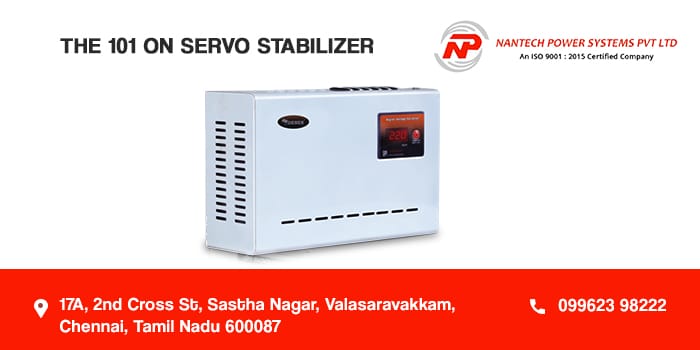
Typically, an industrial load is a three-phase load, and in a real setting, the voltage of the three phases is never balanced. A servo stabilizer is a closed-loop, motor-controlled stabilisation system that maintains a balance between the three phases.
They are called servo stabilizers because they use a servo motor for voltage correction. In some places, they are also known as Servo Controlled Voltage Stabilizer.
A Servo Stabilizer in Chennai has become mandatory for industries, commercial units and offices because they protect all electronics and machines from voltage fluctuations.
What are the advantages of servo stabilizers?
When compared to traditional stabilizers, servo stabilizers offer plenty of advantages in Chennai:
Because they use a servo motor, the output voltage is very accurate. Where input voltage differs up to 50% less or more, the output is + or – 1%! They are capable of supporting almost 5000KVA.
It is these outstanding benefits that make servo stabilizers popular for low-high rating appliances in Chennai and beyond!
Also Read: Busting The Myths Around Inverter Battery!
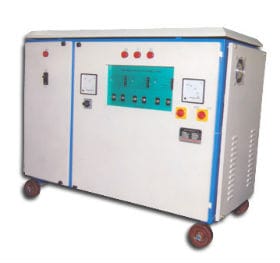
Servo stabilizers have three-phase and single-phase systems. They come in both air-cooled and oil-cooled units.
Both units work on the same principle. They will stabilize voltage and regulate output. For instance, if the stabilizer for an AC receives a low voltage, the buck-boost transform will increase it to the level necessary. Or if the power supply to the AC servo stabilizer is too high, the buck/boost transform will stabilize to the needed voltage.
Both oil and air units may work similarly, but the method through which they show efficiency differs in the two.
These show perfect stable output even when the voltage conditions are severely unbalanced. This is possible because they have an extremely durable motor-controlled stabilization system.
They are called oil-cooled because two things happen – lubrication and cooling. When an application gets heated, oil in the pathways ensures effective cooling of the system.
Air-cooled units are more expensive because of their design. They have a liner in aluminium alloy fins and fans for cooling above 50kVA. One benefit of these units is that they increase the durability of the machine or electric appliance. Moreover, they save you maintenance costs.
Here are some more differences between oil and air-cooled servo stabilizers:
| Servo Stabilizer: Oil cooled | Servo Stabilizer: Air-cooled |
|---|---|
| Cooling by the oil of coiling | Cooling by air of coiling |
| Capillary for oil rotation | Louvers in air-cooled |
| Heavy load in summer | Low load, heats up in summer |
| 30 kVA | 75 kVA |
| Weight 1.5% | Weight 1% |
| 0.8 power factor | 0.9 power factor |
Based on these differences, you can effectively select the right type of servo stabilizer you will need.
<h3">Where Can Oil and Air-Cooled Servo Stabilizers Be Used?
Uses of air-cooled servo stabilizers:
These can be applied in plenty of places, from individual houses to massive manufacturing plants. Air-cooled servo stabilizers are constructed with tailored sizes and capacities dependent on where they are needed:
Uses of oil-cooled servo stabilizers:
These are generally utilised for applications that need over 45kVA power. Air-cooled units are applied where the power required is less than 45kVA. There is an exception to this rule.
For industries that have very high dust like foundry dust or cotton dust and plants that have flammable particles, oil-cooled units are the best even if the requirement is for lower capacities.
This is essential because they prevent fire accidents and help with trouble-free performances.
Applications of Servo Stabilizers
Servo stabilizers can be used for house appliances like:
Commercial Areas
Hotels, malls, theatres, restaurants and more can utilise servo stabilizers for:
The best option for commercial places is usually an air-cooled servo stabilizer to prevent issues that come with voltage fluctuation in Chennai.
Servo stabilizers can be applied for a wide range of industries in Chennai to attain voltage efficiency:
If you are looking for reliable, competent, safe and most of all, advanced Servo Stabilizer in Chennai, then the best choice is Nantech. Get in touch to find the perfect unit for your requirements!
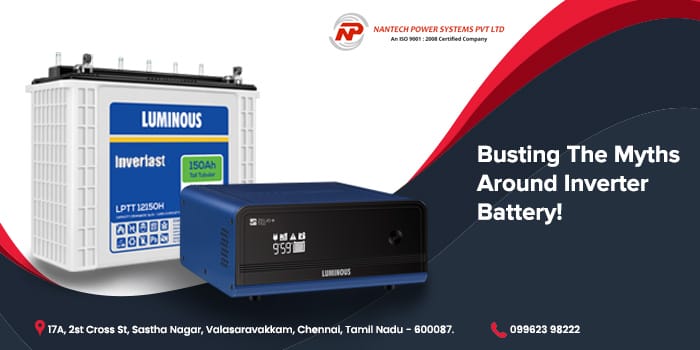
At Nantech, the one question we get asked and asked often by our customers in Chennai is if an inverter battery can power the entire home. To put the question to rest once and for all, we use this blog to bust the number one myth around inverter backup systems.
No, an inverter battery can not provide backup for the entire home, especially in the 21st century where houses are chock full of gadgets that need electricity to run. So, if you are buying an inverter battery in Chennai with the hope that it will provide power come hell or high water, read this blog to gain a better understanding.
Before we dive into why an inverter battery is not capable of powering the whole home, let’s look at what started the myth. There are some homes that can be powered by a battery system. These homes are few and far between because they are small and do not use power-hungry devices like swimming pools and air conditioners. As they place only a few demands on the battery, they can run on a battery backup for quite some time.
Also Read: The EV Revolution: Is Chennai Ready For It?
It is these small houses that have given birth to the myth that batteries can run an entire home. The reality is far from it. Typically, an inverter works best when it is used by the bear minimum appliances, and the battery capacity is rationed.
Why can’t inverter batteries power a whole house? There are two reasons why a home cannot be powered by a battery alone. One, an inverter battery is not powerful enough to give the kick start needed by large appliances to operate. Two, the lithium-ion batteries in an inverter do not have the energy capacity to supply electricity to a whole house for long, extended hours.
These two engineering limits make it impossible for an inverter to supply uninterrupted power to a modern house. The first thing that pops to the mind after reading the last paragraph is “why not invest in multiple batteries to solve the limitations on the power supply?”
The answer is simple: the cost of buying and installing several 20+ or 40+ kilowatt battery inverters is too high for the average homeowner. Because it is financially prohibitive, few opt for the solution. What most people do is take a more practical approach, which is to connect only critical loads to the inverter.
This means electric stoves, air conditioning, washing machines or dishwashers are not connected to the battery. Simple, small, and essential circuits like fans, lights and a convenience outlet are linked to the backup power supply. This ensures the continuous electricity is supplied until the main power comes back online.
Let’s say you still choose to connect your entire Chennai home to the inverter battery. In that case, how long will it be able to power all the appliances? The answer is not for a long time.
Here are a few figures to explain why:
High-power appliances like a central air conditioner, pool pump or electric stove consume boatloads of electricity. To be exact, it is 5000 watts, 2200 watts and 10,000 watts respectively.
Now let’s say you experienced a power cut in the evening, and your battery is down to 2.5-kilowatt capacity. It means the inverter only has enough juice to run the AC unit for half an hour, the pump for one hour and the stove for barely 15 minutes.
In short, high-power gadgets make it impossible for a battery to provide backup to the whole house for long hours. If you leave any one of these devices running, the battery will run out of power soon enough. In plain words, your home in Chennai will have no lights, and no fan, leaving you without a single luxury!
Yes, of course. People have been using inverter batteries in Chennai as power backups for a long time for a reason. The fundamental solution is to switch off all appliances that consume a lot of power when there is an electricity cut. It makes sure that no extra load is put on the battery and the house has continued power supply even for an entire night.
The problem with this solution is that if the cut occurs at night when no one is awake to shut off any extra appliances. The workaround to this is not to connect such devices to the backup in the first place. Since they are not linked to the inverter’s supply, then need not be switched off during a cut.
One more solution is to use battery backups coupled with solar panels. A well designed solar and inverter system can power your house for a long time. The keyword is well designed:
The Future Of Power Backups
In the coming time, smart homes will be able to address most problems that come hand in hand with inverters. Instead of relying on a human to shed any unnecessary load from the battery, the smart home will automatically be able to do so. One example is a smart electric panel that automatically manages the circuits in those and breaks those of large appliances in the event of a blackout.
Till the time such smart technology becomes commonplace in Chennai and takes care of the limitations of backups, the best and the most economical way to power your house is an inverter battery!